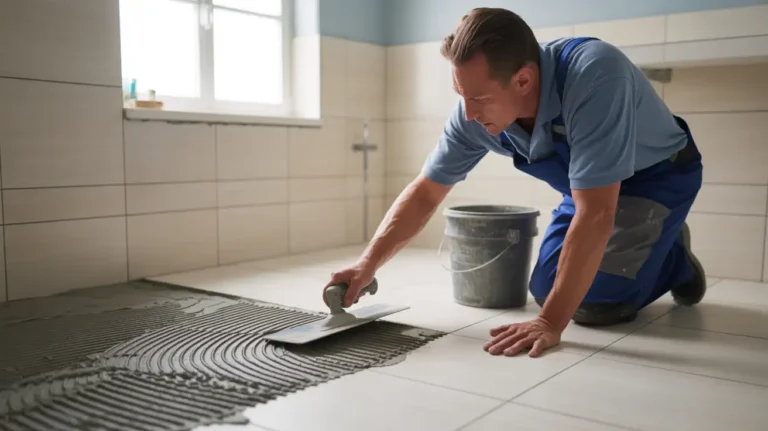
When starting a tile project or fixing up areas like the bathroom or kitchen, many homeowners get confused between grout and caulk. Both are used to fill gaps and seal spaces, but they serve very different purposes. This confusion can lead to using the wrong material in the wrong place, which often causes more problems down the line.
Understanding the real difference in the grout vs caulk debate is key to protecting your home from water damage, cracks, and mold growth. Using each material where it belongs helps maintain a clean finish and keeps your remodel lasting longer. Making the right choice early saves time, money, and costly repairs later.
Table of Contents
What Is Grout?
Grout is a dense paste made from cement, sand, and water, used to fill spaces between tiles and lock them in place. It adds strength and stability, especially in showers, floors, and backsplashes, where moisture is common. While newer options like a groutless shower or grout in a tube exist, traditional grout still plays a key role in finishing tile edges cleanly. However, grout isn’t flexible like grout caulk, so it may crack if the surface shifts or expands.
Types of Grout
Now that you have a basic idea of what grout is, let’s take a closer look at the different types available and when to use each one.
Unsanded Grout
This smooth-textured grout is perfect for thin joints under 1/8 inch and works well on walls and delicate tile surfaces. It’s often used in areas where precision and clean finishes matter.
Sanded Grout
Designed for wider gaps, this type includes sand for added strength. It’s ideal for floors and heavier tiles where strong bonding is needed to hold the stuff between tiles securely.
Epoxy Grout
Highly durable and resistant to water, stains, and chemicals, epoxy grout is often considered the best shower tile sealant. It’s perfect for wet zones like bathrooms and kitchens.
Furan Grout
Mostly used in industrial spaces, furan grout is built to withstand chemicals and heat. It’s rarely used in homes but good to know for specialized needs.
The right grout depends on tile spacing, moisture levels, and durability needs especially in the grout vs caulk choice for bathrooms and kitchens. For flexible edges, grout and caulking may be used together.
Uses for Grout

Grout is mainly used to lock tiles in place and fill the stuff between tiles to keep surfaces smooth and secure. Whether you’re installing tiles on bathroom walls, kitchen backsplashes, or floors, grout provides strength and helps prevent shifting. For straight lines and durable finishes, especially when finishing tile edges, grout remains a go-to solution.
Here’s where grout is commonly used:
- Sealing floor tiles in kitchens and living areas
- Installing wall tiles in wet zones like bathrooms
- Providing structure in tub surrounds before applying caulk
- As an alternative, grout in a tube can be used for small fixes
However, grout is not made for flexible areas that expand or shift. For example, around bathtubs or wall corners, you’ll want to consider the grout versus caulk option carefully. For flexibility and waterproofing in high-moisture areas, caulk or the best shower tile sealant is the better choice.
What Is Caulk?
Caulk is a soft, flexible material made from silicone, latex, or rubber-like compounds, used to seal gaps where movement is expected. It’s commonly applied in corners, edges, and joints to keep out water and air. Homeowners often ask about the difference between grout and caulk, especially in wet areas, since tile caulk or grout caulk offers flexibility where grout would crack.
Types of Caulk
Now that you understand what caulk is, let’s explore the various types of grout so you can choose the right one for each specific use.
Silicone Caulk
Ideal for wet and humid areas like bathtubs, showers, and sinks. Silicone is waterproof, long-lasting, and flexible making it a smart choice for areas that expand and contract with temperature changes.
Acrylic Latex Caulk
Easy to apply and paintable, this type works well in dry indoor areas such as baseboards or crown molding. It’s a great solution when appearance matters and moisture isn’t a major concern.
Polyurethane Caulk
Known for its strength and durability, polyurethane caulk is often used for sealing joints on exteriors like windows, siding, and roofs. It holds up well under weather exposure and heavy use. “Use silicone caulk around bathtubs and sinks for a waterproof seal.”
Whether it’s caulk vs grout or grout vs caulk, the choice depends on the surface and how much movement it will face. For finishing tile edges, use caulk where flexibility is needed, and grout where strength and support are key.
Uses for Caulk

Caulk is commonly used to seal gaps in areas that face regular moisture or temperature changes, like bathrooms, kitchens, windows, and doors. It prevents leaks, drafts, and even insects from sneaking into small cracks. In the grout vs caulk debate, caulk is the flexible solution perfect for movement-prone spaces like the joint between a tub and tile.
Here’s where tile caulk or grout caulk is most useful:
- Around sinks, bathtubs, and shower corners
- Sealing edges between countertops and walls
- Filling gaps between different building materials
- As the best shower tile sealant in moisture-heavy spots
While grout stays firm, caulk wears down over time and should be inspected regularly. Reapplying it when cracks appear keeps your surfaces sealed and protected. And remember, never use caulk as a replacement for the stuff between tiles; each material has its job.
Can You Use Grout and Caulk Together?
Yes, you can use grout and caulk together, but only in the right places. Grout is best for filling the stuff between tiles, providing strength and structure. Caulk is ideal for areas prone to movement, like corners or around tubs where flexibility is needed to prevent cracks.
Do’s:
- Use grout for tiles on floors and walls.
- Use caulk for sealing between the tub and wall or around edges.
- Choose tile caulk for waterproofing in wet areas.
Don’ts:
- Don’t use grout in expansion joints.
- Avoid using grout where flexibility is needed.
- Don’t substitute grout in a tube for caulk in movement zones.
Understanding the difference between grout and caulk helps you choose the right material for the job, ensuring a durable, long-lasting finish.
Professional Help When You Need It
Sometimes, a DIY project just isn’t enough especially when dealing with extensive tile damage, water damage, or mold growth. Improper use of materials like grout or caulk can lead to costly repairs and headaches down the road. That’s where professional help comes in. At San Diego Home Remodeling, our team of experts ensures the correct materials are used in the right way, offering reliable handyman services and bathroom remodeling services tailored to your needs.
With years of local expertise, timely service, and a commitment to quality workmanship, we handle your projects with precision and care. Don’t risk future problems, trust the professionals who understand the importance of using grout and caulk correctly. Contact us today for expert advice and efficient solutions.
FAQs
Can you apply caulk over grout?
It’s not recommended to apply caulk directly over grout. If you’re updating your surfaces, it’s best to remove the old grout or use an appropriate filler before applying caulk to ensure a proper seal and finish.
How long does caulk last compared to grout?
Caulk typically lasts 5 to 10 years, depending on the type and exposure to moisture. Grout, on the other hand, can last much longer if properly sealed and maintained, often outlasting caulk in high-traffic areas.
Is caulk waterproof?
Yes, most silicone-based caulks are waterproof, making them ideal for use around bathtubs, sinks, and other wet areas. For the best protection, choose caulk designed specifically for bathrooms or kitchens.
Do I need to seal grout?
Yes, grout should be sealed unless you’re using epoxy grout, which is naturally water-resistant and doesn’t require sealing. Sealing grout helps protect against stains, moisture, and mold growth, especially in high-humidity areas.
Can I DIY or should I hire a pro?
Small DIY projects, like reapplying caulk or fixing minor grout issues, are manageable for many homeowners. However, for larger or more complex jobs, such as water damage restoration or extensive bathroom remodeling, it’s best to hire a professional to ensure the work is done correctly and lasts long-term.
